*NURSING > Book Review > TEST BANK Pharmacology and the Nursing Process 9th Edition Linda Lane Lilley, Shelly Rainforth Colli (All)
TEST BANK Pharmacology and the Nursing Process 9th Edition Linda Lane Lilley, Shelly Rainforth Collins, Julie S. Snyder _ all chapters 1-58 complete questions, answers, rationales > A+ Guide
Document Content and Description Below
Contents Chapter 01: The Nursing Process and Drug Therapy ....................................................................................4 Chapter 02: Pharmacologic Principles..................... ........................................................................................8 Chapter 03: Lifespan Considerations..........................................................................................................14 Chapter 04: Cultural, Legal, and Ethical Considerations.............................................................................20 Chapter 05: Medication Errors: Preventing and Responding .....................................................................26 Chapter 06: Patient Education and Drug Therapy ......................................................................................29 Chapter 07: Over-the-Counter Drugs and Herbal and Dietary Supplements.............................................34 Chapter 08: Gene Therapy and Pharmacogenomics..................................................................................38 Chapter 09: Photo Atlas of Drug Administration........................................................................................41 Chapter 10: Analgesic Drugs.......................................................................................................................50 Chapter 11: General and Local Anesthetics................................................................................................57 Chapter 12: Central Nervous System Depressants and Muscle Relaxants.................................................61 Chapter 13: Central Nervous System Stimulants and Related Drugs.........................................................66 Chapter 14: Antiepileptic Drugs..................................................................................................................70 Chapter 15: Antiparkinson Drugs................................................................................................................76 Chapter 16: Psychotherapeutic Drugs........................................................................................................81 Chapter 17: Substance Use Disorder..........................................................................................................88 Chapter 18: Adrenergic Drugs.....................................................................................................................93 Chapter 19: Adrenergic-Blocking Drugs......................................................................................................98 Chapter 20: Cholinergic Drugs..................................................................................................................103 Chapter 21: Cholinergic-Blocking Drugs ...................................................................................................108 Chapter 22: Antihypertensive Drugs.........................................................................................................113 Chapter 23: Antianginal Drugs..................................................................................................................119 Chapter 24: Heart Failure Drugs ...............................................................................................................125 Chapter 25: Antidysrhythmic Drugs..........................................................................................................131 Chapter 26: Coagulation Modifier Drugs..................................................................................................137 Chapter 27: Antilipemic Drugs..................................................................................................................143 Chapter 28: Diuretic Drugs........................................................................................................................148 Chapter 29: Fluids and Electrolytes..........................................................................................................154 Chapter 30: Pituitary Drugs.......................................................................................................................160 Chapter 31: Thyroid and Antithyroid Drugs..............................................................................................163 Chapter 32: Antidiabetic Drugs.................................................................................................................168 Chapter 33: Adrenal Drugs........................................................................................................................177 Chapter 34: Women’s Health Drugs.........................................................................................................181 Chapter 35: Men’s Health Drugs...............................................................................................................188 Chapter 36: Antihistamines, Decongestants, Antitussives, and Expectorants.........................................193 Chapter 37: Respiratory Drugs..................................................................................................................198 Chapter 38: Antibiotics Part 1...................................................................................................................204 Chapter 39: Antibiotics Part 2...................................................................................................................211 Chapter 40: Antiviral Drugs.......................................................................................................................216 Chapter 41: Antitubercular Drugs.............................................................................................................221 Chapter 42: Antifungal Drugs....................................................................................................................226 Chapter 43: Antimalarial, Antiprotozoal, and Anthelmintic Drugs...........................................................231 Chapter 44: Anti-inflammatory and Antigout Drugs.................................................................................236 Chapter 45: Antineoplastic Drugs Part 1: Cancer Overview and Cell Cycle–Specific Drugs.....................242 Chapter 46: Antineoplastic Drugs Part 2: Cell Cycle–Nonspecific Drugs and Miscellaneous Drugs.........248 Chapter 47: Biologic Response–Modifying and Antirheumatic Drugs......................................................253 Chapter 48: Immunosuppressant Drugs...................................................................................................258 Chapter 49: Immunizing Drugs .................................................................................................................263 Chapter 50: Acid-Controlling Drugs..........................................................................................................268 Chapter 51: Bowel Disorder Drugs............................................................................................................274 Chapter 52: Antiemetic and Antinausea Drugs ........................................................................................281 Chapter 53: Vitamins and Minerals ..........................................................................................................286 Chapter 54: Anemia Drugs........................................................................................................................292 Chapter 55: Nutritional Supplements.......................................................................................................299 Chapter 56: Dermatologic Drugs ..............................................................................................................304 Chapter 57: Ophthalmic Drugs .................................................................................................................310 Chapter 58: Otic Drugs..............................................................................................................................315 Chapter 01: The Nursing Process and Drug Therapy 4 Chapter 01: The Nursing Process and Drug Therapy MULTIPLE CHOICE 1. The nurse is writing a nursing diagnosis for a plan of care for a patient who has been newly diagnosed with type 2 diabetes. Which statement reflects the correct format for a nursing diagnosis? a. Anxiety b. Anxiety related to new drug therapy c. Anxiety related to anxious feelings about drug therapy, as evidenced by statements such as “I’m upset about having to test my blood sugars.” d. Anxiety related to new drug therapy, as evidenced by statements such as “I’m upset about having to test my blood sugars.” ANS: D Formulation of nursing diagnoses is usually a three-step process. “Anxiety” is missing the “related to” and “as evidenced by” portions of defining characteristics. “Anxiety related to new drug therapy” is missing the “as evidenced by” portion of defining characteristics. The statement beginning “Anxiety related to anxious feelings” is incorrect because the “related to” section is simply a restatement of the problem “anxiety,” not a separate factor related to the response. DIF: COGNITIVE LEVEL: Understanding (Comprehension) TOP: NURSING PROCESS: Nursing Diagnosis MSC: NCLEX: Safe and Effective Care Environment: Management of Care 2. The patient is to receive oral guaifenesin (Mucinex) twice a day. Today, the nurse was busy and gave the medication 2 hours after the scheduled dose was due. What type of problem does this represent? a. “Right time” b. “Right dose” c. “Right route” d. “Right medication” ANS: A “Right time” is correct because the medication was given more than 30 minutes after the scheduled dose was due. “Dose” is incorrect because the dose is not related to the time the medication administration is scheduled. “Route” is incorrect because the route is not affected. “Medication” is incorrect because the medication ordered will not change. DIF: COGNITIVE LEVEL: Applying (Application) TOP: NURSING PROCESS: Implementation MSC: NCLEX: Safe and Effective Care Environment: Safety and Infection Control 3. The nurse has been monitoring the patient’s progress on a new drug regimen since the first dose and documenting the patient’s therapeutic response to the medication. Which phase of the nursing process do these actions illustrate? a. Nursing diagnosis Chapter 01: The Nursing Process and Drug Therapy 5 b. Planning c. Implementation d. Evaluation ANS: D Monitoring the patient’s progress, including the patient’s response to the medication, is part of the evaluation phase. Planning, implementation, and nursing diagnosis are not illustrated by this example. DIF: COGNITIVE LEVEL: Understanding (Comprehension) TOP: NURSING PROCESS: Evaluation MSC: NCLEX: Safe and Effective Care Environment: Management of Care 4. The nurse is assigned to a patient who is newly diagnosed with type 1 diabetes mellitus. Which statement best illustrates an outcome criterion for this patient? a. The patient will follow instructions. b. The patient will not experience complications. c. The patient will adhere to the new insulin treatment regimen. d. The patient will demonstrate correct blood glucose testing technique. ANS: D “Demonstrating correct blood glucose testing technique” is a specific and measurable outcome criterion. “Following instructions” and “not experiencing complications” are not specific criteria. “Adhering to new regimen” would be difficult to measure. DIF: COGNITIVE LEVEL: Applying (Application) TOP: NURSING PROCESS: Planning MSC: NCLEX: Safe and Effective Care Environment: Management of Care 5. Which activity best reflects the implementation phase of the nursing process for the patient who is newly diagnosed with hypertension? a. Providing education on keeping a journal of blood pressure readings b. Setting goals and outcome criteria with the patient’s input c. Recording a drug history regarding over-the-counter medications used at home d. Formulating nursing diagnoses regarding deficient knowledge related to the new treatment regimen ANS: A Education is an intervention that occurs during the implementation phase. Setting goals and outcomes reflects the planning phase. Recording a drug history reflects the assessment phase. Formulating nursing diagnoses reflects analysis of data as part of planning. DIF: COGNITIVE LEVEL: Applying (Application) TOP: NURSING PROCESS: Implementation MSC: NCLEX: Safe and Effective Care Environment: Management of Care 6. The medication order reads, “Give ondansetron (Zofran) 4 mg, 30 minutes before beginning chemotherapy to prevent nausea.” The nurse notes that the route is missing from the order. What is the nurse’s best action? Chapter 01: The Nursing Process and Drug Therapy 6 a. Give the medication intravenously because the patient might vomit. b. Give the medication orally because the tablets are available in 4-mg doses. c. Contact the prescriber to clarify the route of the medication ordered. d. Hold the medication until the prescriber returns to make rounds. ANS: C A complete medication order includes the route of administration. If a medication order does not include the route, the nurse must ask the prescriber to clarify it. The intravenous and oral routes are not interchangeable. Holding the medication until the prescriber returns would mean that the patient would not receive a needed medication. DIF: COGNITIVE LEVEL: Applying (Application) TOP: NURSING PROCESS: Implementation MSC: NCLEX: Safe and Effective Care Environment: Management of Care 7. When the nurse considers the timing of a drug dose, which factor is appropriate to consider when deciding when to give a drug? a. The patient’s ability to swallow b. The patient’s height c. The patient’s last meal d. The patient’s allergies ANS: C The nurse must consider specific pharmacokinetic/pharmacodynamic drug properties that may be affected by the timing of the last meal. The patient’s ability to swallow, height, and allergies are not factors to consider regarding the timing of the drug’s administration. DIF: COGNITIVE LEVEL: Understanding (Comprehension) TOP: NURSING PROCESS: Assessment MSC: NCLEX: Safe and Effective Care Environment: Management of Care 8. The nurse is performing an assessment of a newly admitted patient. Which is an example of subjective data? a. Blood pressure 158/96 mm Hg b. Weight 255 pounds c. The patient reports that he uses the herbal product ginkgo. d. The patient’s laboratory work includes a complete blood count and urinalysis. ANS: C Subjective data include information shared through the spoken word by any reliable source, such as the patient. Objective data may be defined as any information gathered through the senses or that which is seen, heard, felt, or smelled. A patient’s blood pressure, weight, and laboratory tests are all examples of objective data. DIF: COGNITIVE LEVEL: Understanding (Comprehension) TOP: NURSING PROCESS: Assessment MSC: NCLEX: Safe and Effective Care Environment: Management of Care MULTIPLE RESPONSE Chapter 01: The Nursing Process and Drug Therapy 7 1. When giving medications, the nurse will follow the rights of medication administration. The rights include the right documentation, the right reason, the right response, and the patient’s right to refuse. Which of these are additional rights? (Select all that apply.) a. Right drug b. Right route c. Right dose d. Right diagnosis e. Right time f. Right patient ANS: A, B, C, E, F Additional rights of medication administration must always include the right drug, right dose, right time, right route, and right patient. The right diagnosis is incorrect. DIF: COGNITIVE LEVEL: Remembering (Knowledge) TOP: NURSING PROCESS: Implementation MSC: NCLEX: Safe and Effective Care Environment: Safety and Infection Control 2. Place the phases of the nursing process in the correct order, with 1 as the first phase and 5 as the last phase. (Select all that apply.) a. Planning b. Evaluation c. Assessment d. Implementation e. Nursing Diagnoses ANS: A, B, C, D, E The nursing process is an ongoing process that begins with assessing and continues with diagnosing, planning, implementing, and evaluating. DIF: COGNITIVE LEVEL: Applying (Application) TOP: NURSING PROCESS: General MSC: NCLEX: Safe and Effective Care Environment: Management of Care Chapter 02: Pharmacologic Principles 8 Chapter 02: Pharmacologic Principles MULTIPLE CHOICE 1. The patient is receiving two different drugs. At current dosages and dosage forms, both drugs are absorbed into the circulation in identical amounts. Which term is used to identify this principle? a. Bioequivalent b. Synergistic c. Prodrugs d. Steady state ANS: A Two drugs absorbed into the circulation in the same amount (in specific dosage forms) have the same bioavailability; thus, they are bioequivalent. A drug’s steady state is the physiologic state in which the amount of drug removed via elimination is equal to the amount of drug absorbed from each dose. The term synergistic refers to two drugs, given together, with a resulting effect that is greater than the sum of the effects of each drug given alone. A prodrug is an inactive drug dosage form that is converted to an active metabolite by various biochemical reactions once it is inside the body. DIF: COGNITIVE LEVEL: Understanding (Comprehension) TOP: NURSING PROCESS: Implementation MSC: NCLEX: Physiological Integrity: Pharmacological and Parenteral Therapies 2. When given an intravenous medication, the patient says to the nurse, “I usually take pills. Why does this medication have to be given in the arm?” What is the nurse’s best answer? a. “The medication will cause fewer adverse effects when given intravenously.” b. “The intravenous medication will have delayed absorption into the body’s tissues.” c. “The action of the medication will begin sooner when given intravenously.” d. “There is a lower chance of allergic reactions when drugs are given intravenously.” ANS: C An intravenous (IV) injection provides the fastest route of absorption. The IV route does not affect the number of adverse effects, nor does it cause delayed tissue absorption (it results in faster absorption). The IV route does not affect the number of allergic reactions. DIF: COGNITIVE LEVEL: Understanding (Comprehension) TOP: NURSING PROCESS: Implementation MSC: NCLEX: Physiological Integrity: Pharmacological and Parenteral Therapies 3. The nurse is administering parenteral drugs. Which statement is true regarding parenteral drugs? a. Parenteral drugs bypass the first-pass effect. b. Absorption of parenteral drugs is affected by reduced blood flow to the stomach. c. Absorption of parenteral drugs is faster when the stomach is empty. d. Parenteral drugs exert their effects while circulating in the bloodstream. ANS: A Chapter 02: Pharmacologic Principles 9 Drugs given by the parenteral route bypass the first-pass effect. Reduced blood flow to the stomach and the presence of food in the stomach apply to enteral drugs (taken orally), not to parenteral drugs. Parenteral drugs must be absorbed into cells and tissues from the circulation before they can exert their effects; they do not exert their effects while circulating in the bloodstream. DIF: COGNITIVE LEVEL: Understanding (Comprehension) TOP: NURSING PROCESS: General MSC: NCLEX: Physiological Integrity: Pharmacological and Parenteral Therapies 4. When monitoring the patient receiving an intravenous infusion to reduce blood pressure, the nurse notes that the patient’s blood pressure is extremely low, and the patient is lethargic and difficult to awaken. This would be classified as which type of adverse drug reaction? a. Adverse effect b. Allergic reaction c. Idiosyncratic reaction d. Pharmacologic reaction ANS: D A pharmacologic reaction is an extension of a drug’s normal effects in the body. In this case, the antihypertensive drug lowered the patient’s blood pressure levels too much. The other options do not describe a pharmacologic reaction. An adverse effect is a predictable, well-known adverse drug reaction that results in minor or no changes in patient management. An allergic reaction (also known as a hypersensitivity reaction) involves the patient’s immune system. An idiosyncratic reaction is unexpected and is defined as a genetically determined abnormal response to normal dosages of a drug. DIF: COGNITIVE LEVEL: Understanding (Comprehension) TOP: NURSING PROCESS: General MSC: NCLEX: Physiological Integrity: Pharmacological and Parenteral Therapies 5. The nurse is reviewing pharmacology terms for a group of newly graduated nurses. Which sentence defines a drug’s half-life? a. The time it takes for the drug to cause half of its therapeutic response b. The time it takes for one half of the original amount of a drug to reach the target cells c. The time it takes for one half of the original amount of a drug to be removed from the body d. The time it takes for one half of the original amount of a drug to be absorbed into the circulation ANS: C A drug’s half-life is the time it takes for one half of the original amount of a drug to be removed from the body. It is a measure of the rate at which drugs are removed from the body. The other options are incorrect definitions of half-life. DIF: COGNITIVE LEVEL: Understanding (Comprehension) TOP: NURSING PROCESS: General MSC: NCLEX: Physiological Integrity: Pharmacological and Parenteral Therapies Chapter 02: Pharmacologic Principles 10 6. When administering drugs, the nurse remembers that the duration of action of a drug is defined as which of these? a. The time it takes for a drug to elicit a therapeutic response b. The amount of time needed to remove a drug from circulation c. The time it takes for a drug to achieve its maximum therapeutic response d. The time period at which a drug’s concentration is sufficient to cause a therapeutic response ANS: D Duration of action is the time during which drug concentration is sufficient to elicit a therapeutic response. The other options do not define duration of action. A drug’s onset of action is the time it takes for the drug to elicit a therapeutic response. A drug’s peak effect is the time it takes for the drug to reach its maximum therapeutic response. Elimination is the length of time it takes to remove a drug from circulation. DIF: COGNITIVE LEVEL: Understanding (Comprehension) TOP: NURSING PROCESS: General MSC: NCLEX: Physiological Integrity: Pharmacological and Parenteral Therapies 7. When reviewing the mechanism of action of a specific drug, the nurse reads that the drug works by selective enzyme interaction. Which of these processes describes selective enzyme interaction? a. The drug alters cell membrane permeability. b. The drug’s effectiveness within the cell walls of the target tissue is enhanced. c. The drug is attracted to a receptor on the cell wall, preventing an enzyme from binding to that receptor. d. The drug binds to an enzyme molecule and inhibits or enhances the enzyme’s action with the normal target cell. ANS: D With selective enzyme interaction, the drug attracts the enzymes to bind with the drug instead of allowing the enzymes to bind with their normal target cells. As a result, the target cells are protected from the action of the enzymes. This results in a drug effect. The actions described in the other options do not occur with selective enzyme interactions. DIF: COGNITIVE LEVEL: Understanding (Comprehension) TOP: NURSING PROCESS: General MSC: NCLEX: Physiological Integrity: Pharmacological and Parenteral Therapies 8. When administering a new medication to a patient, the nurse reads that it is highly protein bound. Assuming that the patient’s albumin levels are normal, the nurse would expect which result, as compared to a medication that is not highly protein bound? a. Renal excretion will be faster. b. The drug will be metabolized quickly. c. The duration of action of the medication will be shorter. d. The duration of action of the medication will be longer. ANS: D Chapter 02: Pharmacologic Principles 11 Drugs that are bound to plasma proteins are characterized by longer duration of action. Protein binding does not make renal excretion faster, does not speed up drug metabolism, and does not cause the duration of action to be shorter. DIF: COGNITIVE LEVEL: Applying (Application) TOP: NURSING PROCESS: Planning MSC: NCLEX: Physiological Integrity: Pharmacological and Parenteral Therapies 9. The patient is experiencing chest pain and needs to take a sublingual form of nitroglycerin. Where does the nurse instruct the patient to place the tablet? a. Under the tongue b. On top of the tongue c. At the back of the throat d. In the space between the cheek and the gum ANS: A Drugs administered via the sublingual route are placed under the tongue. Drugs administered via the buccal route are placed in the space between the cheek and the gum; oral drugs are swallowed. The other options are incorrect. DIF: COGNITIVE LEVEL: Understanding (Comprehension) TOP: NURSING PROCESS: Implementation MSC: NCLEX: Physiological Integrity: Pharmacological and Parenteral Therapies 10. The nurse is administering medications to the patient who is in renal failure resulting from endstage renal disease. The nurse is aware that patients with kidney failure would most likely have problems with which pharmacokinetic phase? a. Absorption b. Distribution c. Metabolism d. Excretion ANS: D The kidneys are the organs that are most responsible for drug excretion. Renal function does not affect the absorption and distribution of a drug. Renal function may affect metabolism of drugs to a small extent. DIF: COGNITIVE LEVEL: Applying (Application) TOP: NURSING PROCESS: Assessment MSC: NCLEX: Physiological Integrity: Pharmacological and Parenteral Therapies 11. A patient who has advanced cancer is receiving opioid medications around the clock to keep him comfortable as he nears the end of his life. Which term best describes this type of therapy? a. Palliative therapy b. Maintenance therapy c. Empiric therapy d. Supplemental therapy ANS: A Chapter 02: Pharmacologic Principles 12 The goal of palliative therapy is to make the patient as comfortable as possible. It is typically used in the end stages of illnesses when all attempts at curative therapy have failed. Maintenance therapy is used for the treatment of chronic illnesses such as hypertension. Empiric therapy is based on clinical probabilities and involves drug administration when a certain pathologic condition has an uncertain but high likelihood of occurrence based on the patient’s initial presenting symptoms. Supplemental (or replacement therapy) supplies the body with a substance needed to maintain normal function. DIF: COGNITIVE LEVEL: Understanding (Comprehension) TOP: NURSING PROCESS: Implementation MSC: NCLEX: Physiological Integrity: Pharmacological and Parenteral Therapies 12. The patient is complaining of a headache and asks the nurse which over-the-counter medication form would work the fastest to help reduce the pain. Which medication form will the nurse suggest? a. A capsule b. A tablet c. An enteric-coated tablet d. A powder ANS: D Of the types of oral medications listed, the powder form would be absorbed the fastest, thus having a faster onset. The tablet, the capsule, and, finally, the enteric-coated tablet would be absorbed next, in that order. DIF: COGNITIVE LEVEL: Applying (Application) TOP: NURSING PROCESS: Implementation MSC: NCLEX: Physiological Integrity: Pharmacological and Parenteral Therapies 13. The nurse will be injecting a drug into the fatty tissue of the patient’s abdomen. Which route does this describe? a. Intradermal b. Subcutaneous c. Intramuscular d. Transdermal ANS: B Injections into the fatty subcutaneous tissue under the dermal layer of skin are referred to as subcutaneous injections. Injections under the more superficial skin layers immediately underneath the epidermal layer of skin and into the dermal layer are known as intradermal injections. Injections into the muscle beneath the subcutaneous fatty tissue are referred to as intramuscular injections. Transdermal drugs are applied to the skin via an adhesive patch. DIF: COGNITIVE LEVEL: Remembering (Knowledge) TOP: NURSING PROCESS: Implementation MSC: NCLEX: Physiological Integrity: Pharmacological and Parenteral Therapies MULTIPLE RESPONSE Chapter 02: Pharmacologic Principles 13 1. Which drugs would be affected by the first-pass effect? (Select all that apply.) a. Morphine given by IV push injection b. Sublingual nitroglycerin tablets c. Diphenhydramine (Benadryl) elixir d. Levothyroxine (Synthroid) tablets e. Transdermal nicotine patches f. Esomeprazole (Nexium) capsules g. Penicillin given by IV piggyback infusion ANS: C, D, F Orally administered drugs (elixirs, tablets, capsules) undergo the first-pass effect because they are metabolized in the liver after being absorbed into the portal circulation from the small intestine. IV medications (IV push and IV piggyback) enter the bloodstream directly and do not go directly to the liver. Sublingual tablets and transdermal patches also enter the bloodstream without going directly to the liver, thus avoiding the first-pass effect. DIF: COGNITIVE LEVEL: Applying (Application) TOP: NURSING PROCESS: General MSC: NCLEX: Physiological Integrity: Pharmacological and Parenteral Therapies COMPLETION 1. A drug dose that delivers 250 mg has a half-life of 5 hours. Identify how much drug will remain in the body after one half-life. _______ ANS: 125 mg A drug’s half-life is the time required for one half of an administered dose of a drug to be eliminated by the body, or the time it takes for the blood level of a drug to be reduced by 50%. Therefore, one half of 250 mg equals 125 mg. DIF: COGNITIVE LEVEL: Applying (Application) TOP: NURSING PROCESS: Implementation MSC: NCLEX: Physiological Integrity: Pharmacological and Parenteral Therapies [Show More]
Last updated: 1 year ago
Preview 1 out of 318 pages

Reviews( 0 )
Recommended For You
*NURSING> Book Review > Fundamentals key concepts review answer (All)
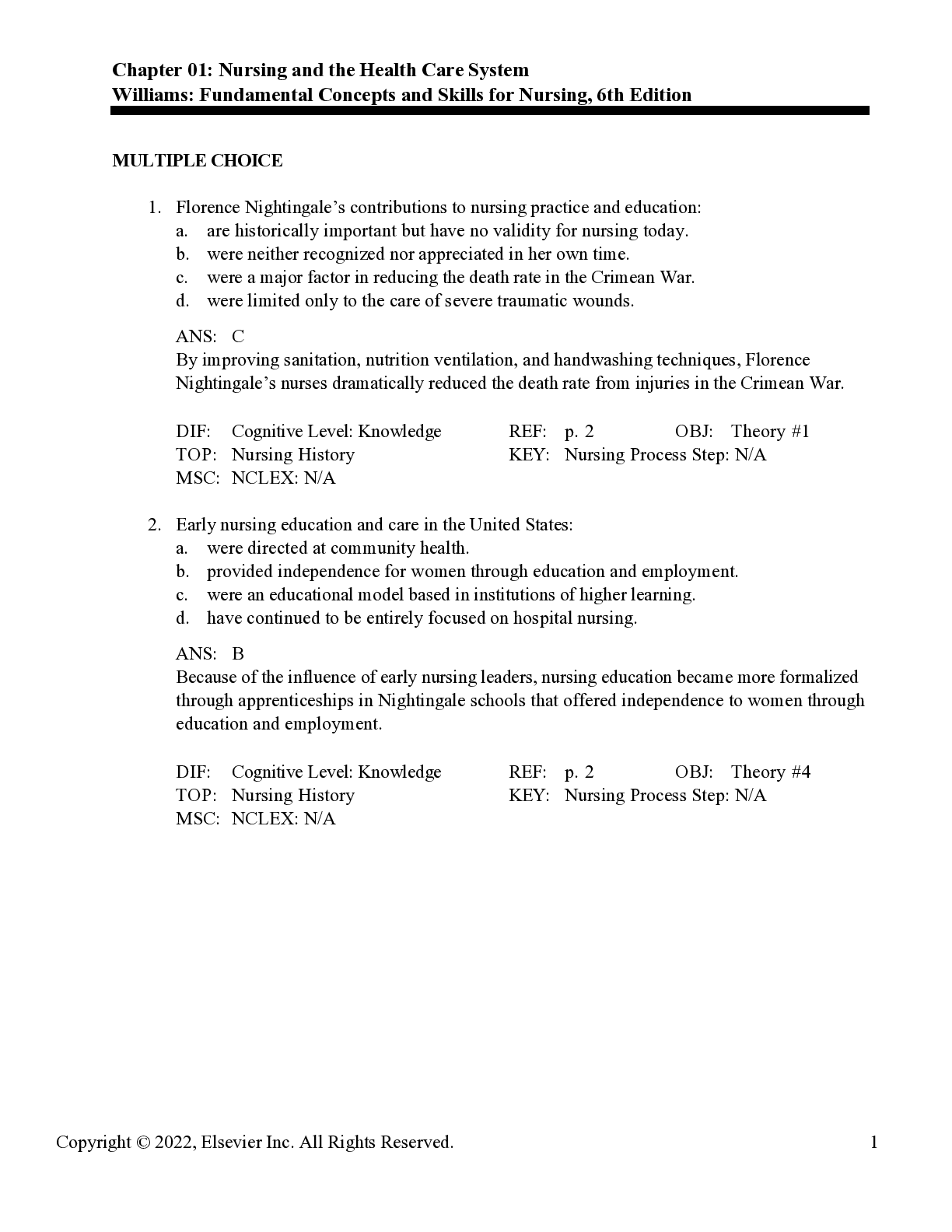
Fundamentals key concepts review answer
Fundamentals exam questions - Fundamentals formal questions on ATI app.t, will help you get a better understanding of how to think as a nurse since the concept of fundamentals best response based on...
By Xbarroso , Uploaded: Apr 19, 2023
$20
NCLEX-RN> Book Review > NCLEX-PN®: POWER PRACTICE (All)

NCLEX-PN®: POWER PRACTICE
The content in this book has been reviewed and updated by the LearningExpress Team in 2019. Copyright © 2013 Learning Express, LLC. All rights reserved under International and Pan American Cop...
By stevenking , Uploaded: Jun 17, 2023
$14
NURS*> Book Review > NR 503 Week 4 Midterm Review Guide (Chapter 1 – 20) (All)
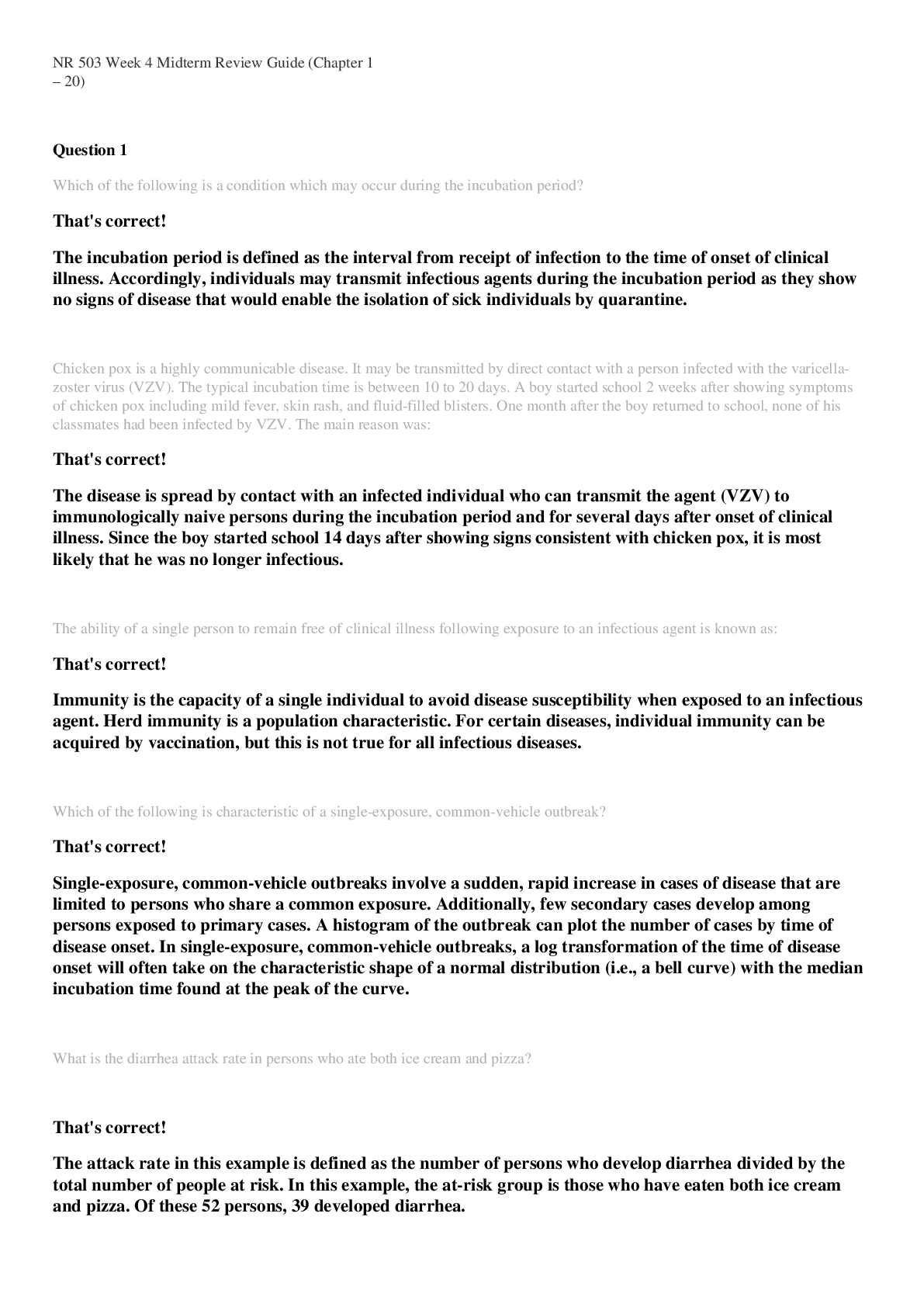
NR 503 Week 4 Midterm Review Guide (Chapter 1 – 20)
NR 503 Week 4 Midterm Review Guide (Chapter 1 – 20) Question 1 Which of the following is a condition which may occur during the incubation period? That's correct! The incubation period is def...
By stevenking , Uploaded: Jun 17, 2023
$13.5
Applied Psychology> Book Review > HESI/Saunders Online Review for the NCLEX-RN Examination (2 Year), 3rd Edition Module 4 Exam (All)
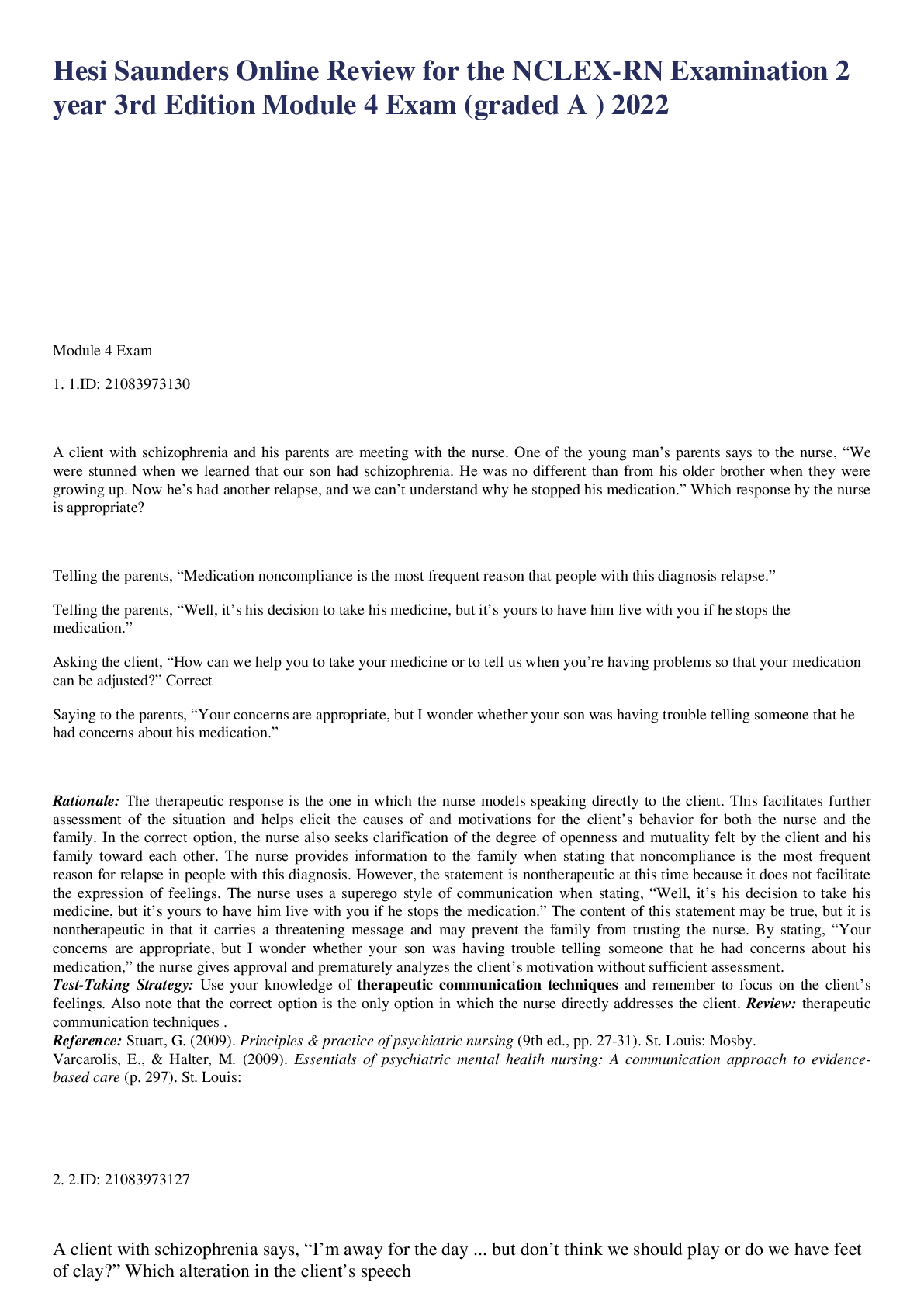
HESI/Saunders Online Review for the NCLEX-RN Examination (2 Year), 3rd Edition Module 4 Exam
HESI/Saunders Online Review for the NCLEX-RN Examination (2 Year), 3rd Edition Module 4 Exam 1. Module 4 Exam 1. 1.ID: 21083973130 A client with schizophrenia says, “I’m away for the day ... but d...
By LEXXIE KNOWLEDGE HUB , Uploaded: Oct 03, 2022
$11
Physical Therapy> Book Review > PSY340 book summaries{ for A+ grade} (All)
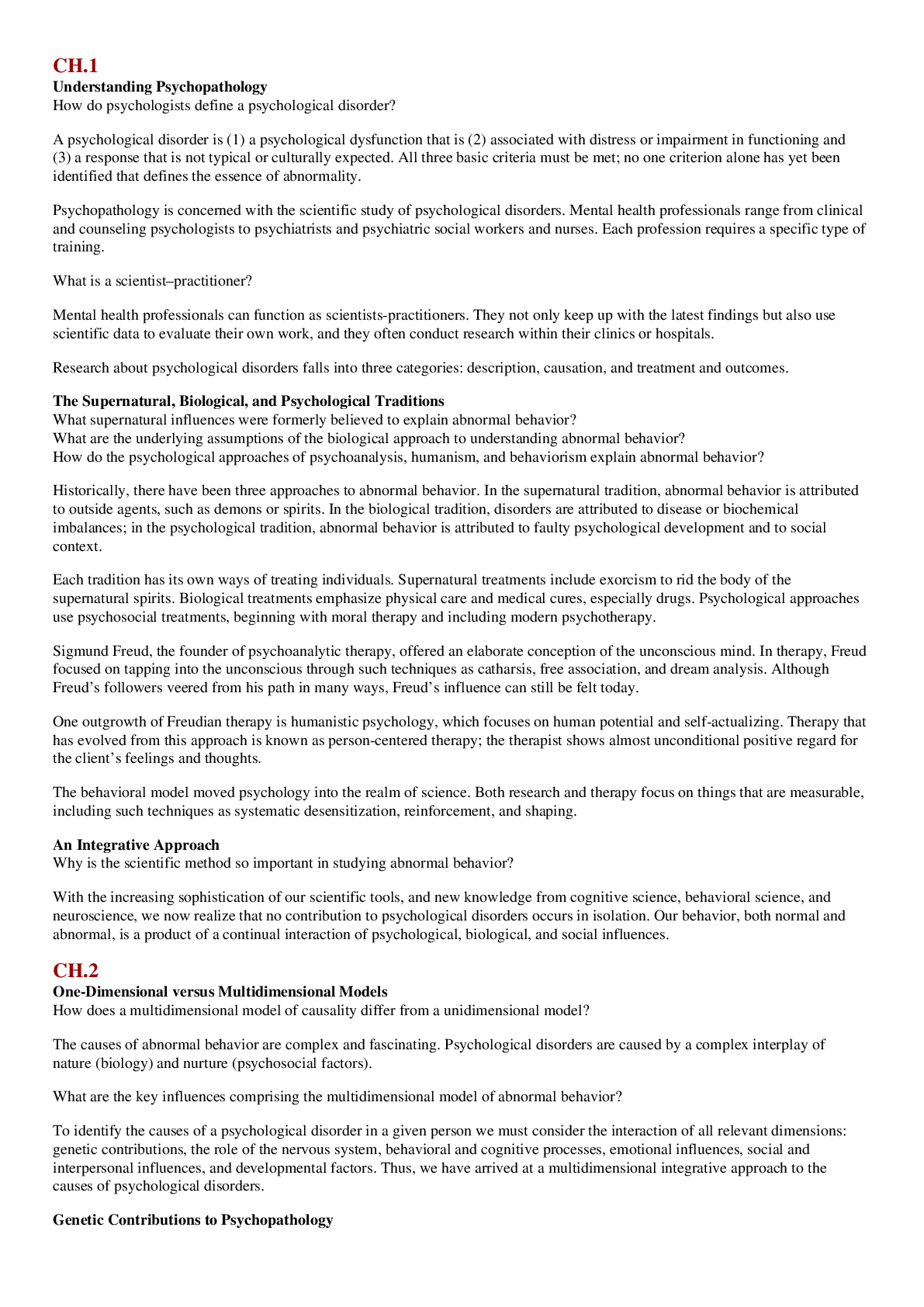
PSY340 book summaries{ for A+ grade}
CH.1 Understanding Psychopathology How do psychologists define a psychological disorder? ● A psychological disorder is (1) a psychological dysfunction that is (2) associated with distress or impair...
By Okinyi Calvins , Uploaded: Oct 07, 2022
$13.5
Programming> Book Review > Why Python language (All)
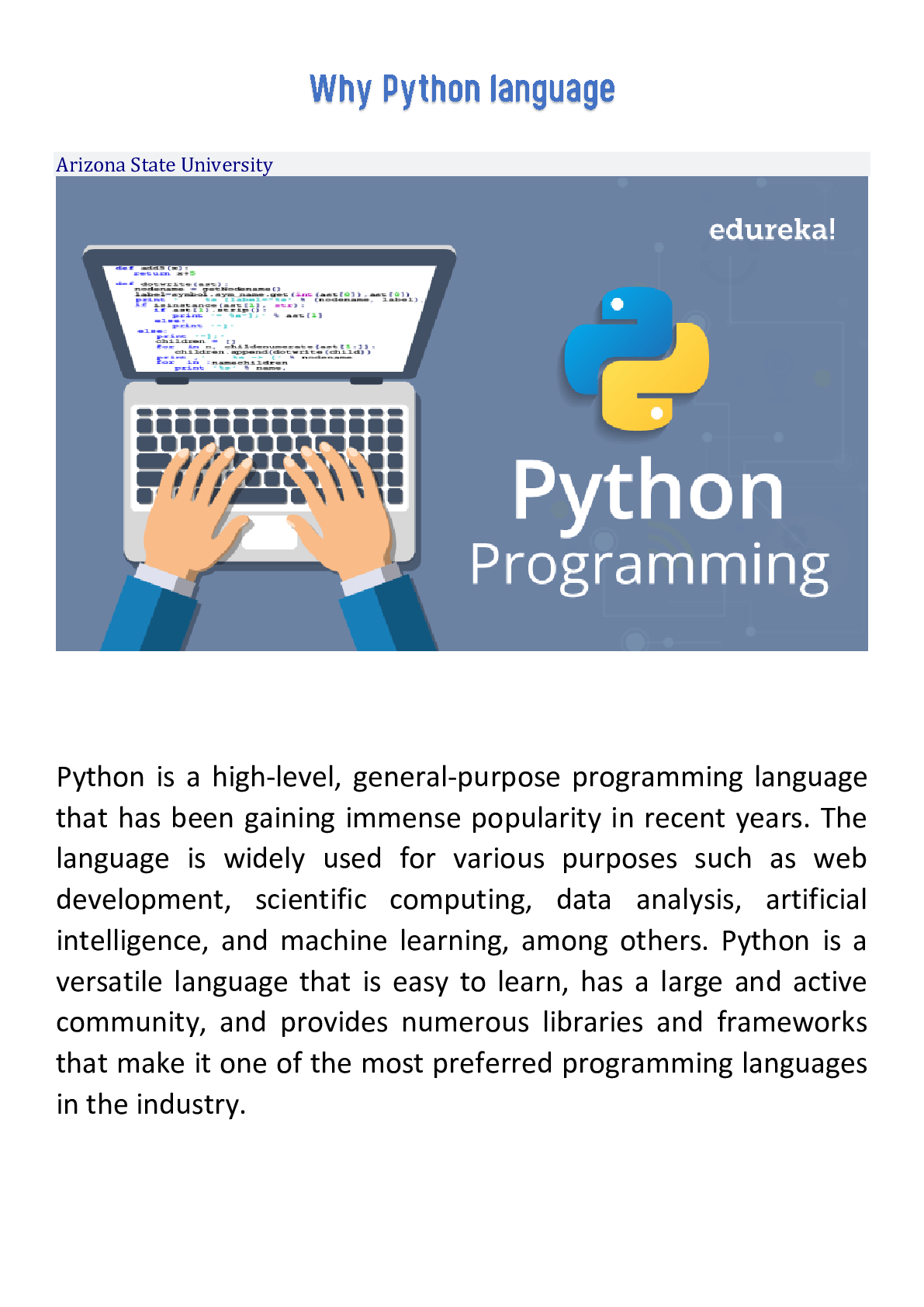
Why Python language
Python is a high-level, general-purpose programming language that has been gaining immense popularity in recent years. The language is widely used for various purposes such as web development, scienti...
By adnan nazer , Uploaded: Apr 19, 2023
$1.5
Political Science> Book Review > L2201_IR_and_Global_Politics_2020_21_Class_Handbook__1 (All)

L2201_IR_and_Global_Politics_2020_21_Class_Handbook__1
L2201_IR_and_Global_Politics_2020_21_Class_Handbook__1
By Hannington , Uploaded: Jun 20, 2023
$13
*NURSING> Book Review > Overcoming Secondary Stress in Medical and Nursing Practice: A Guide to Professional Resilience and Personal Well-Being 2nd Edition (All)

Overcoming Secondary Stress in Medical and Nursing Practice: A Guide to Professional Resilience and Personal Well-Being 2nd Edition
Overcoming Secondary Stress in Medical and Nursing Practice: A Guide to Professional Resilience and Personal Well-Being 2nd Edition
By Tutorsammy , Uploaded: Nov 23, 2022
$8
English Literature> Book Review > A Tale of the Crimea By G. A. HENTY (All)

A Tale of the Crimea By G. A. HENTY
CONTENTS Chapter I. The Midshipman Chapter II. An Adventure at Gib Chapter III. The Escape Chapter IV. Gallipoli Chapter V. A Brush with the Enemy Chapter VI. The Alma Chapter VII. Before Sebas...
By EXCELLENCE NURSING LIBRARY , Uploaded: Nov 26, 2023
$8.5
KAPLAN> Book Review > KAPLAN RN EXIT EXAM V1 (All)

KAPLAN RN EXIT EXAM V1
KAPLAN RN EXIT EXAM V1 KAPLAN RN EXIT EXAM V1 1. The nurse cares for a client diagnosed with superficial partial thickness burn. The nurse should assign the client to a room with which client? A...
By stevenking , Uploaded: Jun 17, 2023
$12.5
Document information
Connected school, study & course
About the document
Uploaded On
Jan 29, 2023
Number of pages
318
Written in
Additional information
This document has been written for:
Uploaded
Jan 29, 2023
Downloads
0
Views
118






